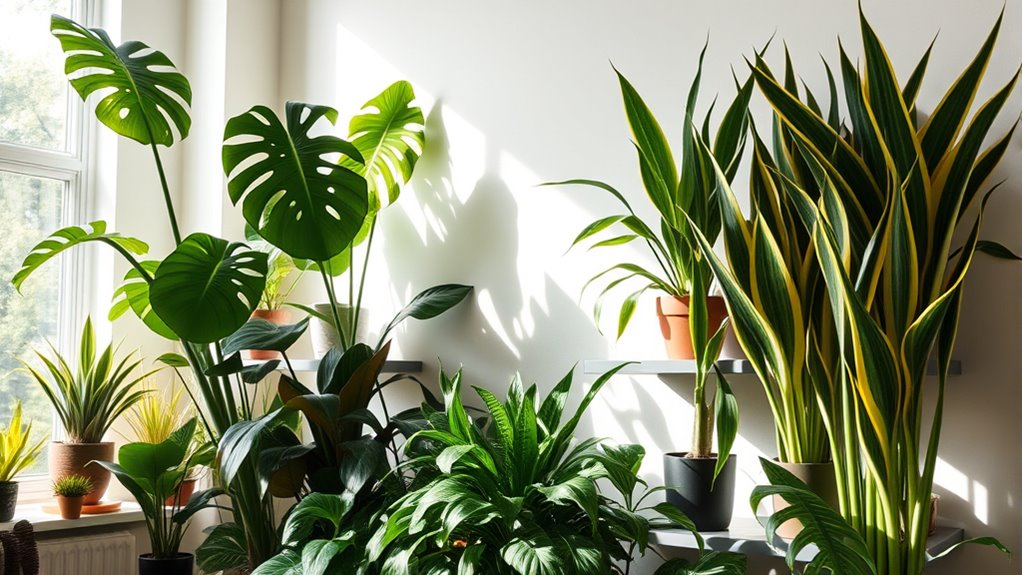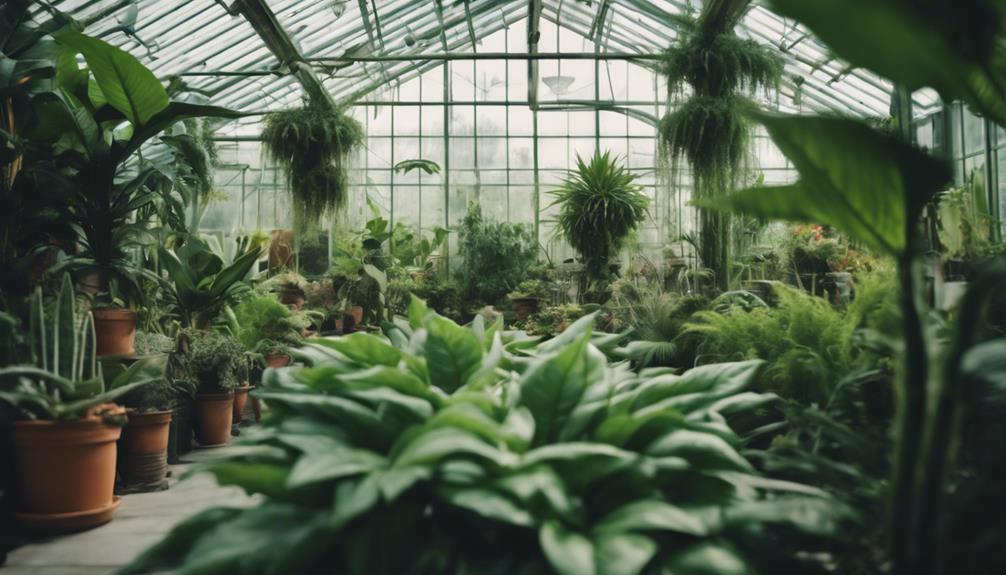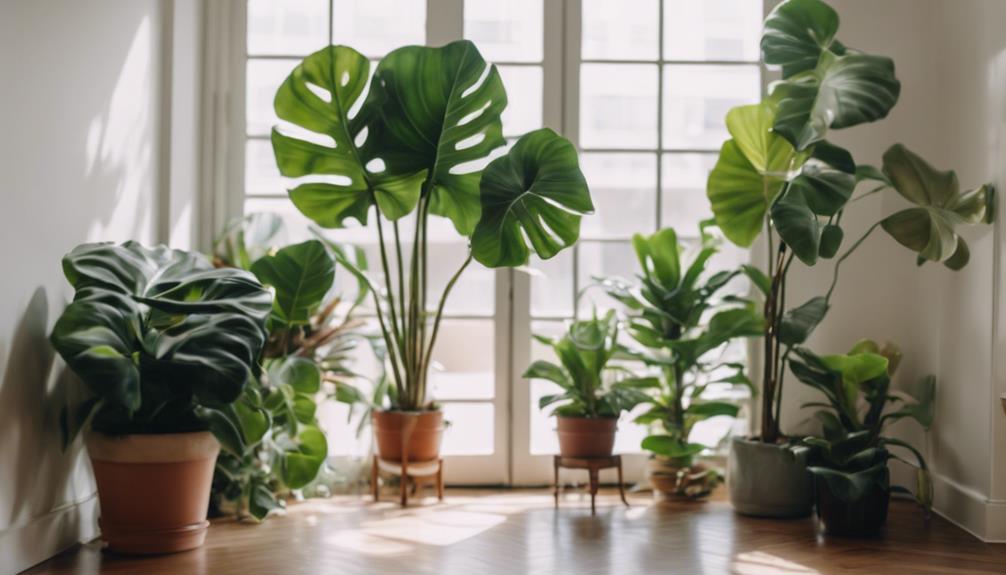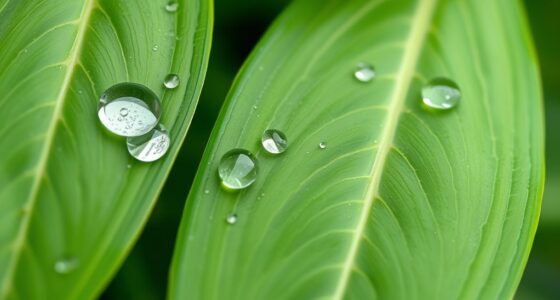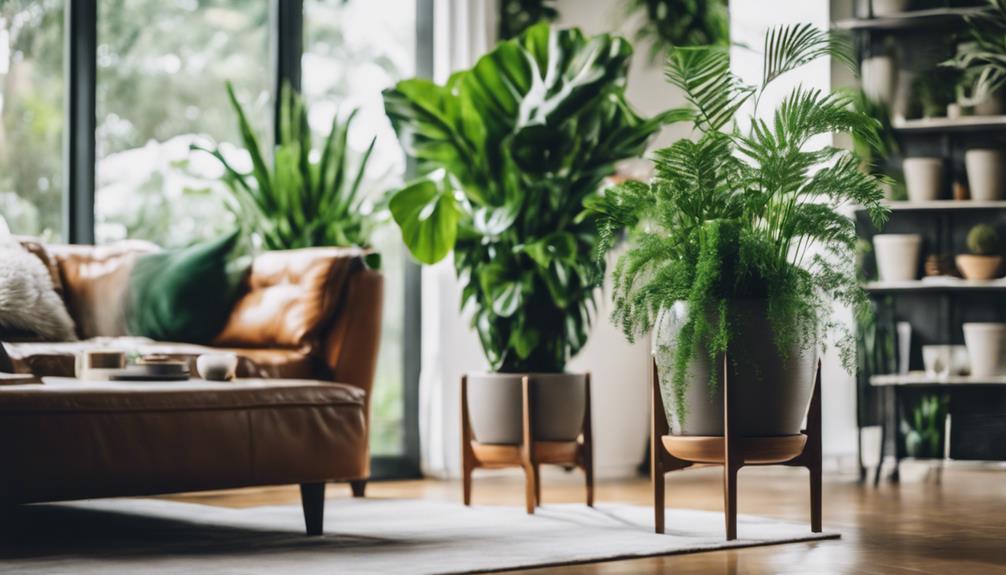If you’re looking to improve your indoor air quality, consider adding trees like the Fiddle Leaf Fig, Areca Palm, or Rubber Plant. These popular choices effectively absorb airborne toxins like formaldehyde, benzene, and trichloroethylene, transforming your space into a healthier environment. Proper care keeps them thriving and guarantees their air-purifying powers work at their best. Stay with us to explore how to select, maintain, and care for these beneficial indoor trees.
Key Takeaways
- Fiddle Leaf Fig, Areca Palm, and Rubber Plant are top choices for air purification indoors.
- These trees effectively absorb airborne toxins like formaldehyde, benzene, and trichloroethylene.
- Proper care, including adequate sunlight, watering, and humidity, enhances their air-filtering capabilities.
- Regular maintenance, such as leaf cleaning and pest control, maximizes their pollutant removal efficiency.
- Using AI and innovative care techniques can optimize indoor trees’ health and air-cleaning performance.
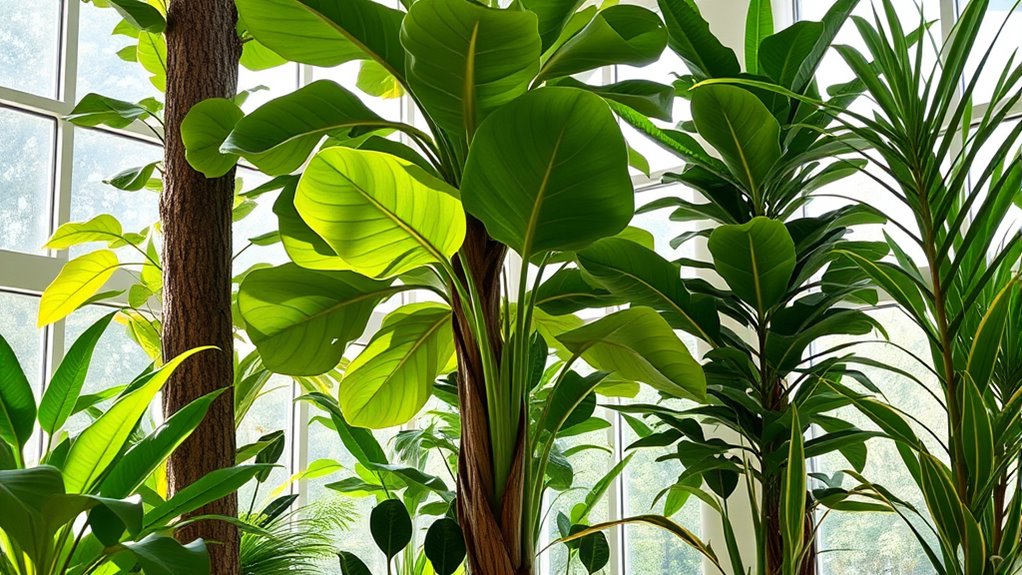
Indoor trees not only add aesthetic appeal to your space but also considerably improve air quality. They act as natural air purifiers, helping to remove toxins and pollutants from the environment. When you choose the right indoor trees, you’re not just enhancing your decor; you’re creating a healthier living or working space. To maximize the air purification benefits, it’s essential to understand how to care for these trees properly. Proper care and maintenance ensure that your indoor trees stay healthy, vibrant, and effective at filtering the air.
First, selecting the right trees is crucial. Some of the best options include the Fiddle Leaf Fig, Areca Palm, and the Rubber Plant. These species are known for their ability to absorb airborne toxins like formaldehyde, benzene, and trichloroethylene. Once you’ve picked your trees, pay close attention to their specific care requirements. Light is a key factor; most indoor trees thrive in bright, indirect sunlight. If natural light is limited, consider supplementing with grow lights to keep your trees healthy and ensure they continue providing air purification benefits.
Watering habits are equally important. Overwatering can lead to root rot, while underwatering causes stress and leaf drop. Generally, you should water when the top inch of soil feels dry. Keep in mind that humidity levels also impact their health. Many indoor trees prefer higher humidity, so mist their leaves regularly or place a humidifier nearby if your space is dry. Proper fertilization during the growing season supports their growth and keeps them vigorous in filtering indoor air.
Regular pruning is vital for maintaining the shape and health of your trees. Removing dead or yellowing leaves allows the plant to focus its energy on new growth and enhances the overall air purification benefits. Additionally, keep an eye out for pests like spider mites or scale, as they can weaken your trees and reduce their ability to clean the air. Use gentle, plant-safe insecticides or natural remedies to manage infestations early.
Cleaning the leaves periodically with a damp cloth helps maximize their ability to photosynthesize and absorb pollutants. This simple maintenance step prevents dust buildup and ensures your indoor trees stay healthy and effective at filtering air. Interestingly, the integration of AI-powered tools in plant care is emerging to help monitor and optimize the health of indoor trees. Remember, consistent care and attention to their specific needs will keep your indoor trees thriving, delivering cleaner air and a more inviting environment. When you prioritize proper care and maintenance, your indoor trees will reward you with their beauty and the air purification benefits they provide, making your space healthier and more enjoyable.
Frequently Asked Questions
Which Indoor Trees Are Safest for Homes With Pets?
When choosing indoor trees for your home, safety is key, especially with pets around. You should look for pet safe plants that are non-toxic, ensuring your furry friends stay safe. Many popular trees, like the parlor palm and areca palm, are non-toxic, making them a great choice. Avoid toxic plants to prevent any accidental poisoning. Always double-check whether a plant is toxic vs non-toxic before bringing it indoors.
How Often Should Indoor Trees Be Watered for Optimal Air Purification?
You should water your indoor trees when the top inch of soil feels dry to guarantee ideal air purification efficiency. Typically, watering frequency varies based on the tree type, pot size, and indoor conditions, but most need watering once a week. Avoid overwatering, which can harm the tree and reduce air purification. Consistent, appropriate watering helps your trees thrive and maximizes their ability to clean the air effectively.
Do Indoor Trees Require Special Soil or Fertilizers?
Indoor trees generally need well-draining soil that matches their soil requirements, ensuring proper root health. You should also monitor their fertilization needs, as they benefit from balanced, slow-release fertilizers during the growing season. Avoid over-fertilizing, which can harm the plant. Using the right soil and providing appropriate fertilization helps your indoor trees stay healthy, thrive, and effectively purify the air in your home.
Can Indoor Trees Help Reduce Indoor Humidity Levels?
Indoor trees can help with humidity control through plant transpiration, which releases moisture into the air. As you care for your trees, they naturally increase indoor humidity levels, making your space more comfortable, especially in dry environments. By choosing the right indoor trees and maintaining proper watering, you create a balanced environment that benefits both the plants and your overall indoor air quality.
Are There Any Indoor Trees That Thrive in Low-Light Conditions?
You’ll be amazed—there are shade-tolerant trees that practically thrive in near darkness! If you’re wondering whether any indoor trees can handle low-light conditions, the answer is yes. Low light plants like certain indoor trees can flourish with minimal sunlight, transforming dim corners into lush, green retreats. These resilient, low-light plants are perfect for spaces with limited sunlight, proving you don’t need a sunny window to enjoy the beauty of indoor trees.
Conclusion
Having indoor trees not only beautifies your space but also boosts your health. Did you know that NASA’s research shows certain indoor plants can remove up to 87% of airborne toxins in just 24 hours? By choosing the right trees, you create a fresher, cleaner environment where you can breathe easier every day. So, bring a little greenery inside—you’ll enjoy cleaner air and a more vibrant home.
